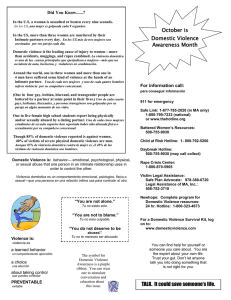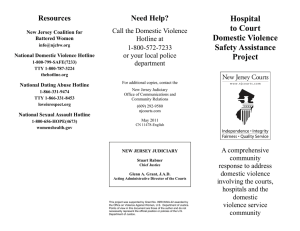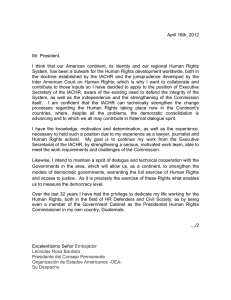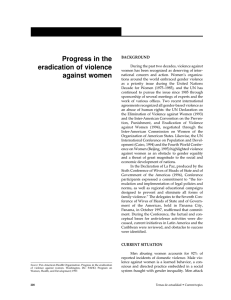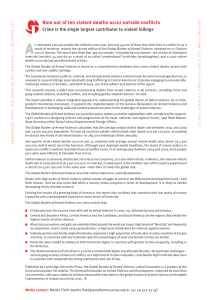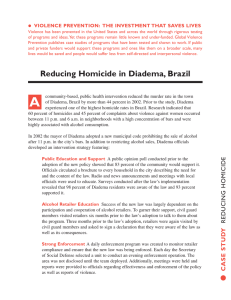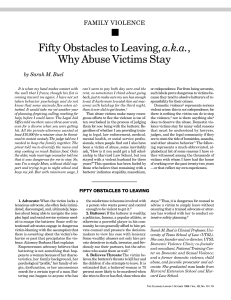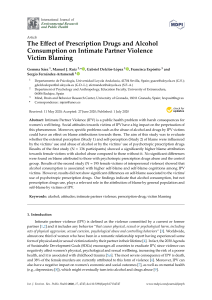Facts and figures: violence against women - EIGE
Anuncio
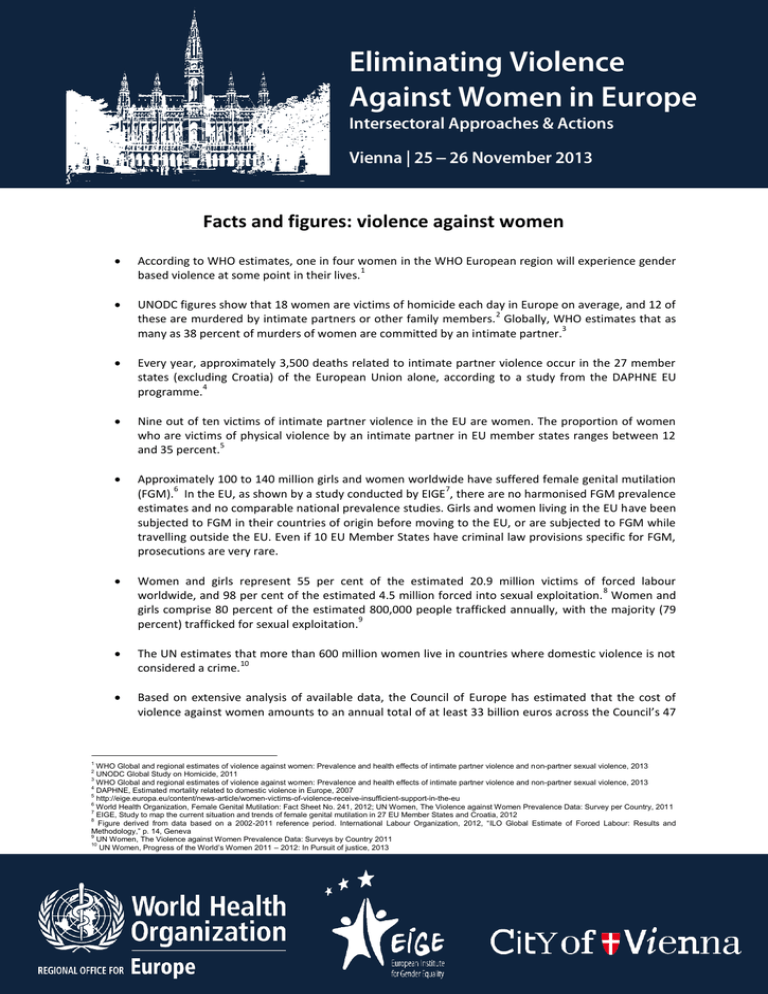
Facts and figures: violence against women 1 According to WHO estimates, one in four women in the WHO European region will experience gender 1 based violence at some point in their lives. UNODC figures show that 18 women are victims of homicide each day in Europe on average, and 12 of 2 these are murdered by intimate partners or other family members. Globally, WHO estimates that as 3 many as 38 percent of murders of women are committed by an intimate partner. Every year, approximately 3,500 deaths related to intimate partner violence occur in the 27 member states (excluding Croatia) of the European Union alone, according to a study from the DAPHNE EU 4 programme. Nine out of ten victims of intimate partner violence in the EU are women. The proportion of women who are victims of physical violence by an intimate partner in EU member states ranges between 12 5 and 35 percent. Approximately 100 to 140 million girls and women worldwide have suffered female genital mutilation 6 7 (FGM). In the EU, as shown by a study conducted by EIGE , there are no harmonised FGM prevalence estimates and no comparable national prevalence studies. Girls and women living in the EU have been subjected to FGM in their countries of origin before moving to the EU, or are subjected to FGM while travelling outside the EU. Even if 10 EU Member States have criminal law provisions specific for FGM, prosecutions are very rare. Women and girls represent 55 per cent of the estimated 20.9 million victims of forced labour 8 worldwide, and 98 per cent of the estimated 4.5 million forced into sexual exploitation. Women and girls comprise 80 percent of the estimated 800,000 people trafficked annually, with the majority (79 9 percent) trafficked for sexual exploitation. The UN estimates that more than 600 million women live in countries where domestic violence is not 10 considered a crime. Based on extensive analysis of available data, the Council of Europe has estimated that the cost of violence against women amounts to an annual total of at least 33 billion euros across the Council’s 47 WHO Global and regional estimates of violence against women: Prevalence and health effects of intimate partner violence and non-partner sexual violence, 2013 UNODC Global Study on Homicide, 2011 WHO Global and regional estimates of violence against women: Prevalence and health effects of intimate partner violence and non-partner sexual violence, 2013 4 DAPHNE, Estimated mortality related to domestic violence in Europe, 2007 5 http://eige.europa.eu/content/news-article/women-victims-of-violence-receive-insufficient-support-in-the-eu 6 World Health Organization, Female Genital Mutilation: Fact Sheet No. 241, 2012; UN Women, The Violence against Women Prevalence Data: Survey per Country, 2011 7 EIGE, Study to map the current situation and trends of female genital mutilation in 27 EU Member States and Croatia, 2012 8 Figure derived from data based on a 2002-2011 reference period. International Labour Organization, 2012, “ILO Global Estimate of Forced Labour: Results and Methodology,” p. 14, Geneva 9 UN Women, The Violence against Women Prevalence Data: Surveys by Country 2011 10 UN Women, Progress of the World’s Women 2011 – 2012: In Pursuit of justice, 2013 2 3 Member States, including the financial burden of intervention, policing, healthcare and other 11 services. 12 A study conducted by EIGE reveals that support for victims of violence against women is insufficient: Over 25,000 shelter places for women survivors are missing in the EU. Specialised services for victims of gender-based violence, including counselling and shelters, are unequally distributed in and among EU Member States. Many of them face capacity problems and sustainable funding issues. The least available services are special support services for multi-discriminated groups and specialised programmes to help victims re-enter the labour market, provided by less than 40 per cent of the EU Member States. Intimate partner and sexual violence have serious short and long term physical and mental health 13 consequences for survivors and their children, including for sexual and reproductive health. WHO reports that: 42 per cent of women who experience intimate partner violence report an injury as a consequence of this violence. Women who have been physically or sexually abused by their partners are 16 percent more likely to have low birth weight babies. They are more than twice as likely to have an abortion and almost twice as likely to suffer from depression and problem drinking as women who have not experienced partner violence. They are also at significantly higher risk of suicide. There are fewer data available on the health effects of non-partner sexual violence. However, evidence has shown that women who have experienced non-partner sexual violence are 2.3 times more likely to have alcohol use disorders and 2.6 times more likely to experience depression or anxiety. Witnessing domestic violence and growing up in an environment where violence takes place has a harmful effect on children’s behavioural, emotional and mental health and increases the risk of children suffering from post-traumatic stress symptoms, psychosomatic illnesses, attention deficit 14 disorder and low educational achievement. The initial findings of an EU-wide survey of 42,000 women by the European Agency for Fundamental Rights 15 (FRA), due to be published in 2014, show that: Four out of five women did not turn to any service, such as healthcare, social services, or victim support, following the most serious incidents of violence by people other than their partners. Women who sought help were most likely to turn to medical services. Two out of five women interviewed were unaware of laws or political initiatives in place to protect them in cases of domestic violence; half were not aware of any preventative laws or initiatives. Over three quarters of women think violence against women is common in their country. About half of the women interviewed indicated that they had avoided public or private situations because they were afraid they might be physically or sexually assaulted. 11 Council of Europe: Combating violence against women: stocktaking study, Strasbourg, 2006 EIGE, Review of the implementation of the Bejing Platform for Action by the EU Member States. Violence against Women Victim Support, 2012 WHO Global and regional estimates of violence against women: Prevalence and health effects of intimate partner violence and non-partner sexual violence, 2013 14 Council of Europe: Combating violence against women: stocktaking study, Strasbourg, 2006 15 http://fra.europa.eu/en/news/2013/true-extent-violence-against-women-remains-hidden 12 13



